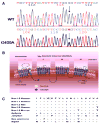SCN5A mutation associated with acute myocardial infarction
- PMID: 19345130
- PMCID: PMC2813686
- DOI: 10.1016/j.legalmed.2009.02.044
SCN5A mutation associated with acute myocardial infarction
Abstract
Ventricular tachycardia and fibrillation (VT/VF) complicating Brugada syndrome, a genetic disorder linked to SCN5A mutations, and VF complicating acute myocardial infarction (AMI) have both been linked to phase 2 reentry. Because of these mechanistic similarities in arrhythmogenesis, we examined the contribution of SCN5A mutations to VT/VF complicating AMI. Nineteen consecutive patients developing VF during AMI were enrolled. Wild-type (WT) and mutant SCN5A genes were co-expressed with SCN1B in TSA201 cells and studied using whole-cell patch-clamp techniques. One missense mutation (G400A) in SCN5A was detected in a conserved region among the cohort of 19 patients. A H558R polymorphism was detected on the same allele. Unlike the other 18 patients who each developed 1-2 VF episodes during acute MI, the mutation carrier developed six episodes of VT/VF within the first 12 hours. All VT/VF episodes were associated with ST segment changes and were initiated by short-coupled extrasystoles. We describe the first sodium channel mutation to be associated with the development of an arrhythmic storm during acute ischemia. These findings suggest that a loss of function in SCN5A may predispose to ischemia induced arrhythmic storm. These results could be very useful for forensic implications regarding genetic screening in relatives.
Conflict of interest statement
Figures

Similar articles
-
Novel mutation in the SCN5A gene associated with arrhythmic storm development during acute myocardial infarction.Heart Rhythm. 2007 Aug;4(8):1072-80. doi: 10.1016/j.hrthm.2007.03.040. Epub 2007 Apr 10. Heart Rhythm. 2007. PMID: 17675083 Free PMC article.
-
Genetic predisposition and cellular basis for ischemia-induced ST-segment changes and arrhythmias.J Electrocardiol. 2007 Nov-Dec;40(6 Suppl):S26-9. doi: 10.1016/j.jelectrocard.2007.05.019. J Electrocardiol. 2007. PMID: 17993325 Free PMC article.
-
Elevated oxidative stress is associated with ventricular fibrillation episodes in patients with Brugada-type electrocardiogram without SCN5A mutation.Cardiovasc Pathol. 2011 Jan-Feb;20(1):e37-42. doi: 10.1016/j.carpath.2010.02.002. Epub 2010 Mar 12. Cardiovasc Pathol. 2011. PMID: 20219395
-
The Brugada syndrome: clinical, electrophysiologic and genetic aspects.J Am Coll Cardiol. 1999 Jan;33(1):5-15. doi: 10.1016/s0735-1097(98)00528-2. J Am Coll Cardiol. 1999. PMID: 9935001 Review.
-
Cellular and ionic mechanisms responsible for the Brugada syndrome.J Electrocardiol. 2000;33 Suppl:33-9. doi: 10.1054/jelc.2000.20321. J Electrocardiol. 2000. PMID: 11265734 Review.
Cited by
-
Case report: Synergetic effect of ischaemia and increased vagal tone inducing ventricular fibrillation in a patient with Brugada syndrome.Eur Heart J Case Rep. 2020 Jul 30;4(4):1-5. doi: 10.1093/ehjcr/ytaa202. eCollection 2020 Aug. Eur Heart J Case Rep. 2020. PMID: 32974459 Free PMC article.
-
Human Plasma Metabolomics Identify 9-cis-retinoic Acid and Dehydrophytosphingosine Levels as Novel biomarkers for Early Ventricular Fibrillation after ST-elevated Myocardial Infarction.Bioengineered. 2022 Feb;13(2):3334-3350. doi: 10.1080/21655979.2022.2027067. Bioengineered. 2022. PMID: 35094641 Free PMC article. Clinical Trial.
-
Epidemiology and genetics of ventricular fibrillation during acute myocardial infarction.J Geriatr Cardiol. 2016 Sep;13(9):789-797. doi: 10.11909/j.issn.1671-5411.2016.09.006. J Geriatr Cardiol. 2016. PMID: 27899944 Free PMC article. Review.
-
Polymorphic Variants of SCN5A Gene (rs41312433 and rs1805124) Associated with Coronary Artery Affliction in Patients with Severe Arrhythmias.Genes (Basel). 2024 Feb 2;15(2):200. doi: 10.3390/genes15020200. Genes (Basel). 2024. PMID: 38397190 Free PMC article.
-
Evaluating the Use of Genetics in Brugada Syndrome Risk Stratification.Front Cardiovasc Med. 2021 Apr 21;8:652027. doi: 10.3389/fcvm.2021.652027. eCollection 2021. Front Cardiovasc Med. 2021. PMID: 33969014 Free PMC article.
References
-
- Roden DM. Human genomics and its impact on arrhythmias. Trends Cardiovasc Med. 2004;14:112–6. - PubMed
-
- Antzelevitch C. Molecular genetics of arrhythmias and cardiovascular conditions associated with arrhythmias. Heart Rhythm. 2004;1:42C–56C. - PubMed
-
- Dumaine R, Towbin JA, Brugada P, Vatta M, Nesterenko DV, Nesterenko VV, et al. Ionic mechanisms responsible for the electrocardiographic phenotype of the Brugada syndrome are temperature dependent. Circ Res. 1999;85:803–9. - PubMed
-
- Noda T, Shimizu W, Taguchi A, Satomi K, Suyama K, Kurita T, et al. ST-segment elevation and ventricular fibrillation without coronary spasm by intracoronary injection of acetylcholine and/or ergonovine maleate in patients with Brugada syndrome. J Am Coll Cardiol. 2002;40:1841–7. - PubMed
Publication types
MeSH terms
Substances
Grants and funding
LinkOut - more resources
Full Text Sources
Medical
Miscellaneous

